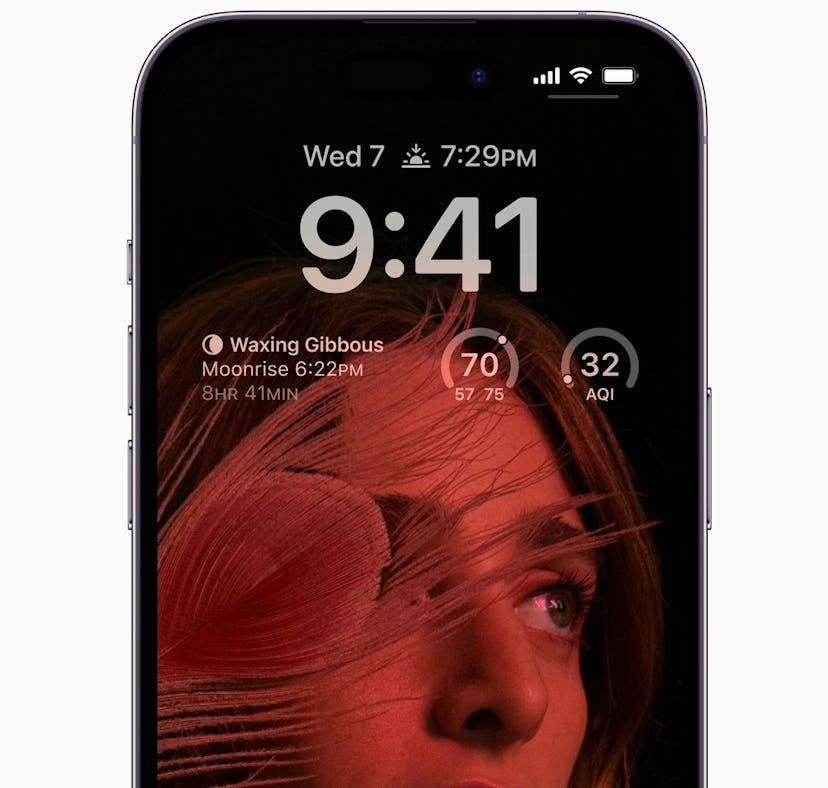
That New Notch On The iPhone 14 Pro Series Actually Does So Much
Apple’s calling it a Dynamic Island.
When Apple unveiled the new iPhone 14 at its annual fall keynote on Sept. 7, fans noticed a slight change to the design of the phone for the higher priced models. The change comes to the notch of the phone, aka the section at the top that has your front facing camera — and it’s only different on two of the four new iPhone models. So what is the iPhone 14’s new notch for, anyway? The updated design, called the Dynamic Island, does a lot. Here’s what you need to know about the new feature before investing in Apple’s most expensive phones.
If you weren’t able to tune into the event, here’s a quick rundown on what you missed. Apple finally launched the new iPhone 14 in four different options — iPhone 14, iPhone 14 Plus, iPhone 14 Pro, and iPhone 14 Pro Max. When the new phones hit store shelves on Sept. 16 (Oct. 7 for iPhone Plus), the new models will include a series of new specs, including some seriously stunning shades of purple. The feature that seems to be flying under the radar, though, is the new dynamic island design on the iPhone 14 Pro and iPhone 14 Pro Max. You have to look pretty carefully to catch it, but once you see it, you won’t be able to miss it.
IYDK, the notch, which made its debut in 2017 with the iPhone X, is the bar at the top of your screen that is home to the front facing camera and the sound bar. Probably the most important aspect of the notch is the fact that it also houses the facial recognition sensors that activate Face ID, hence why it was introduced with the iPhone X. But the elongated design of the notch is officially a thing of the past for iPhone Pro and Pro Max loyalists, because the company has replaced the notch on its newest, most expensive models — iPhone 14 Pro and iPhone 14 Pro Max — with a small pill-shaped cut out at the top of the screen that will take up less screen space than the former design.
The Dynamic Island won’t always stay the same size, though (it is, after all, dynamic). The new feature expands with every notification, and makes it easier to access controls just by touching and holding the interactive tab. Some of the controls you’ll be able to use with the Dynamic Island include accepting phone calls, and monitoring the volume of your headphones, as well as signaling AirPods have been connected and that the iPhone is charging.
If you’re worried that the change to the notch means the iPhone 14 Pro and iPhone 14 Pro Max won’t have Face ID, don’t be — according to a Sept. 7 Apple release, the Dynamic Island will still manage Face ID authentication, and will “fluidly expand into different shapes” when interacting with features like Face ID.
Other ways you’ll notice the Dynamic Island at play include it tracking ongoing background activities like Maps and Apple Music, even when the apps are closed. You’ll also be connected to third-party apps, like sports apps that provide scores or ride-sharing apps that provide updates about where a driver is. It’ll be a new way to stay connected to what you’re doing even when the apps are not open.
One of the very noticeable differences between the old and new notches is the way they are protected by a screen cover. Screen protectors for older iPhone models cut around the bar, leaving the sensors exposed in a long, thin pocket at the top of the screen. The screen protectors for the iPhone 14 Pro and iPhone 14 Pro Max, on the other hand, will cut around the sensors even more precisely, and will look more like a pill than a pocket.
The iPhone 14 Pro and Pro Max are the first iPhones in five years to ditch the OG notch, so even though they come with a hefty starting price tag of $999 and $1099, respectively, the design overhaul might prove to be worth the money.
This article was originally published on